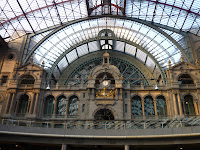- It seems that most of the time the news media gets it wrong in the first several days of covering any story
- Each outlet has its own group of talking heads that it pays to give opinions
- Many experts are just wrong
The first bullet point is proven with recent coverage of the Northwest airline pilots fiasco, the "balloon boy", and, going much further back, runaway brides, WMD's, the Olympic Park bomber, etc. The media jumps on the first information, finds 8-10 seconds of video to play in a continuous loop, and finds some talking head to explain what has happened, even before the facts are out. There must have been six networks convinced that the Northwest pilots had simply fallen asleep. Then there were talking heads going on and on about pilot fatigue, airline cutbacks, and federal oversight - oh, and the aging air traffic control system. Two weeks later we find out that the pilots really were doing what they said, arguing over a Delta scheduling system (Northwest was acquired by Delta - typical problems with merging two companies) on their laptops. No fatigue at all.
Second, the talking heads. Fox News and CNN are great at this. They hire a bunch of retired whatevers (army generals, Newt Gingrich among cast off politicians, folks who work for "think tanks", and guys who have a consulting business that is essentially a contract with the networks) who come on and pontificate about their view of something. Fox is especially good a pitting two folks against one another (read as "fair and balanced") and letting them duke it out on air. Nobody changes the other's mind and it is more like a schoolyard brawl.
Third, this week really hit it for me, the "experts". ABC is doing an "investigative report" (I remember when these were really professionally done back in the 70's and led to the fall of a Presidency) on food safety: "What's in your food?" Yesterday it was beef. Today it was field greens. In both cases, the problem is e-coli contamination. They find some expert at some agency, usually a group for consumer rights, and let them ramble on about "we need more testing", "the government is not inspecting", "the companies only have voluntary compliance". These experts are idiots. It is impossible and prohibitively expensive to test everything. Also, since the testing is destructive, in order to achieve 100% test reliability, there would be no product to consume. For beef, they take hamburger patties at random and remove 8 sub-samples for testing. Frequency of testing was not discussed, but even for the patties tested, 8 small samples from a patty leaves a lot of it untested. Anyway, the consumer expert was upset because the meat was shown to be from 4 cows (genetic testing) instead of what she thought should be one cow. The producer defended his product. In order to get the right mix of fat and lean, different cuts of beef are used and blended to make the finished product. No big deal.
My real "beef" is that the expert is an idiot. Anyone who knows anything about quality management knows that finished product testing is inefficient. It is a disaster check only. True quality management, by the way this is required to get manufacturing costs down, is process driven. If the process is optimized and in-process testing is implemented, then the product will be high quality. As my German colleagues say ... end of story; full stop.
So, for the beef industry that means segregating sick and well animals, proper training of each employee on food safety, automation, temperature control, maintenance schedules, etc. For the greens grower it means testing of water used for irrigation, segregation of cattle land from fields, and all of the same things that the meat packer should do. Are there companies that try to skirt around this? Yes, and they don't survive long but they can harm people by not doing things right. So, spot check these companies and have them certified and re-certify often. Eventually it becomes culture or you close them down. Hefty fines works well too, especially if they are multiplicative: X dollars for the finding and Y dollars more for every day from the date of the problem (findings can be retroactive) until the problem is fixed. Under any circumstances, more testing, which seems to be the only answer the expert has, will not help.
The problem is compounded. Hopefully our younger generation is more news savvy, but way too many folks depend on network or cable outlets for "facts". They hear this tripe and then believe it and suddenly, you have a bunch of folks yelling at Congress to act and those nuts usually put on the whole show and make a mockery out of real science. It really seems to me that our national IQ is low into the double digits.








